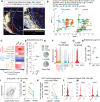This is a preprint.
Critical role of CD206+ macrophages in promoting a cDC1-NK-CD8 T cell anti-tumor immune axis
- PMID: 37961697
- PMCID: PMC10635006
- DOI: 10.1101/2023.10.31.560822
Critical role of CD206+ macrophages in promoting a cDC1-NK-CD8 T cell anti-tumor immune axis
Update in
-
Targeting CD206+ macrophages disrupts the establishment of a key antitumor immune axis.J Exp Med. 2025 Jan 6;222(1):e20240957. doi: 10.1084/jem.20240957. Epub 2024 Nov 27. J Exp Med. 2025. PMID: 39601781 Free PMC article.
Abstract
Tumor-associated macrophages (TAMs) are frequently categorized as being 'M1' or 'M2' polarized, even as substantial data challenges this binary modeling of macrophage cell state. One molecule consistently referenced as a delineator of a putative immunosuppressive 'M2' state is the surface protein CD206. We thus made a novel conditional CD206 (Mrc1) knock-in mouse to specifically visualize and/or deplete CD206+ 'M2-like' TAMs and assess their correspondence with pro-tumoral immunity. Early, but not late depletion of CD206+ macrophages and monocytes (here, 'Mono/Macs') led to an indirect loss of a key anti-tumor network of NK cells, conventional type I dendritic cells (cDC1) and CD8 T cells. Among myeloid cells, we found that the CD206+ TAMs are the primary producers of CXCL9, and able to differentially attract activated CD8 T cells. In contrast, a population of stress-responsive TAMs ("Hypoxic" or Spp1+) and immature monocytes, which lack CD206 expression and become prominent following early depletion, expressed markedly diminished levels of CXCL9. Those NK and CD8 T cells which enter CD206-depleted tumors express vastly reduced levels of the corresponding receptor Cxcr3, the cDC1-attracting chemokine Xcl1 and cDC1 growth factor Flt3l transcripts. Consistent with the loss of this critical network, early CD206+ TAM depletion decreased tumor control by antigen specific CD8 T cells in mice. Likewise, in humans, the CD206Replete, but not the CD206Depleted Mono/Mac gene signature correlated robustly with CD8 T cell, NK cell and stimulatory cDC1 gene signatures and transcriptomic signatures skewed towards CD206Replete Mono/Macs associated with better survival. Together, these findings negate the unqualified classification of CD206+ 'M2-like' macrophages as immunosuppressive by illuminating contexts for their role in organizing a critical tumor-reactive archetype of immunity.
Conflict of interest statement
Declaration of Interests: The authors declare no competing interests
Figures





References
Publication types
Grants and funding
LinkOut - more resources
Full Text Sources
Other Literature Sources
Research Materials
Miscellaneous
